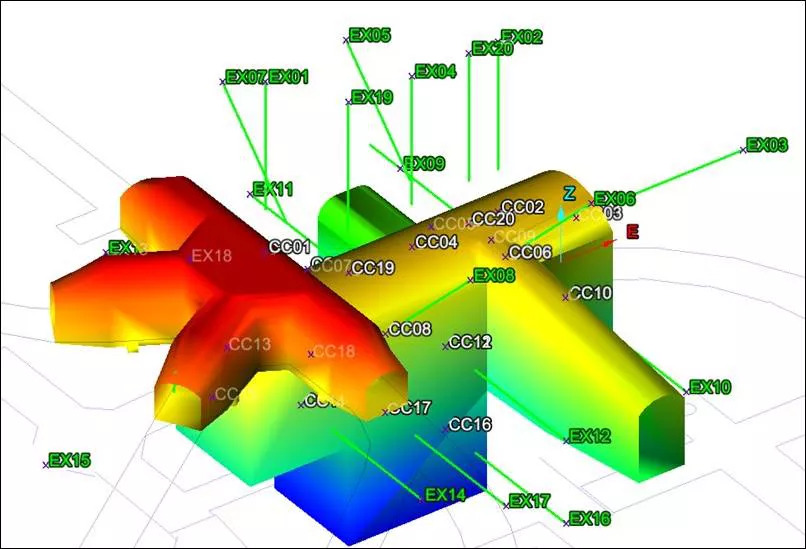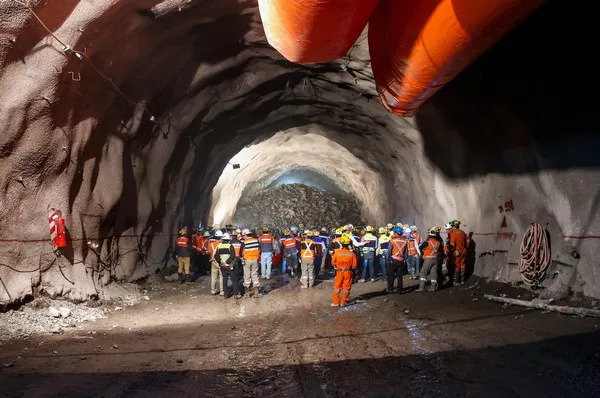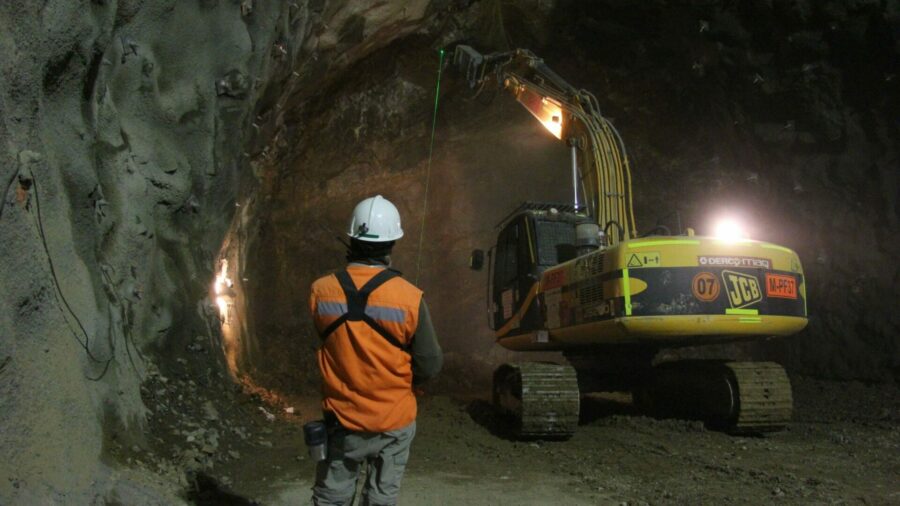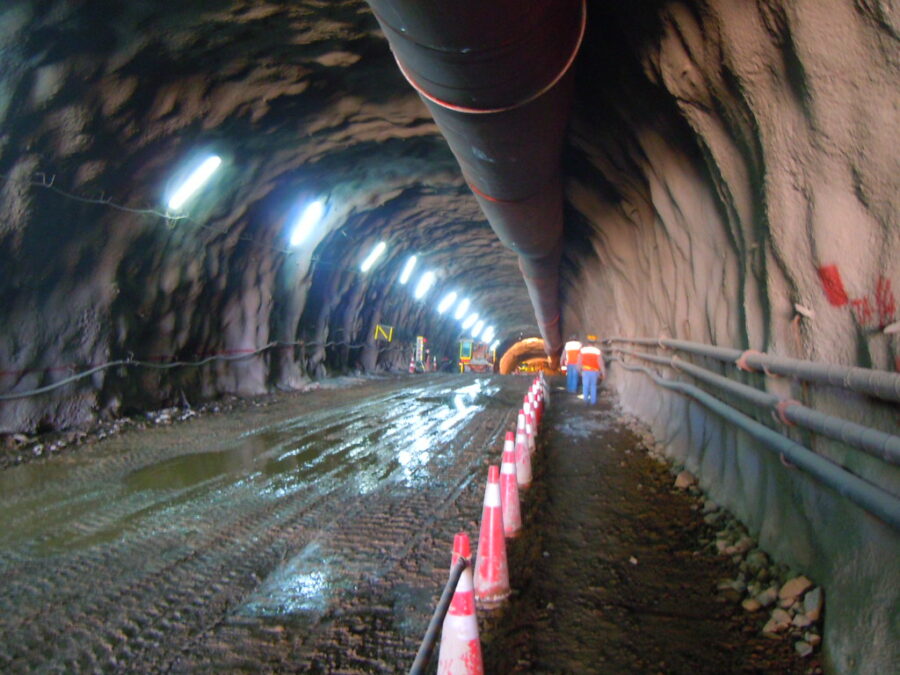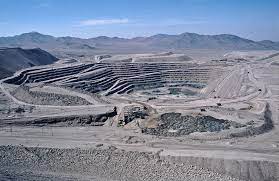Chuquicamata: Monitoring one of the world’s largest underground mines
Challenge
Block caving presents several potential geotechnical hazards. For example, in-situ loads change constantly and, in consequence, so do the demands on the local support and reinforcement systems. This is in addition to over stress, ground deformation due to excavation, rock detonations, and other events that will affect the safety of the mine. Hence the importance of employing geotechnical instrumentation to monitor the different safety variables of a rock mass, the behavior of the support and reinforcement systems, and other important elements.
Another important challenge is the lack of access to electrical power, since traditional dataloggers require constant power from an external source. Furthermore, getting the data out of the mine is an issue, due to the reliance on wires that can easily be accidentally cut, as well as the lack of access to communication nodes that can deliver the data outside the mine.
These were some of the challenges facing Chuquicamata when it began underground mining operations. Codelco entrusted this task to its geotechnical and structural monitoring partner, Geosinergia. Codelco asked for a monitoring system that provided better coverage than traditional solutions, and that reflected the state-of-the-art of modern mining technology. The goal was to deploy a system capable of covering the vastness of Chuquicamata, keeping its operations safe, efficient, and without interruption.
Underground Monitoring Today
Geosinergia prides itself in its strong engineering background, with 20 years of experience in the mining, infrastructure, and civil works sectors. Igor Bravo, Chief Executive Officer (CEO) of the company, and a trained engineer, summed up some of the challenges of monitoring an underground mine:
“When you go underground, it’s a different world. You have to work with specialized instruments like in-situ stress systems, which are much more complex and feature dozens of sensors. Everybody ‘gets’ an open pit. But an underground mine? Not so much”
Until now, there have been few new developments in underground monitoring. Traditional wire-based solutions have always been cumbersome, expensive, and precarious. They involve deploying many kilometers of wire to connect the sensors, a wire that is very vulnerable to the transit of heavy machinery. Mine features like shafts, bent tunnels, or winzes further complicate the deployment of these systems, and make them more prone to malfunctioning as well as increasing the cost. Moreover, given the remoteness and difficulty in accessing certain parts of the mine (some of the sensors are set up in areas where no human presence is expected), repairs and regular maintenance are often not realistic options.
These are some of the reasons why historically many mine operators have done away with wires and resorted to manual data collection. However, these are also unreliable, producing data that’s inconsistent and – critically – with large gaps between readings. Ground movements can happen in just a matter of seconds, endangering lives and equipment, hence why constant data availability is key in order to enable quick decision-making.
Solution
However, block caving presents several potential geotechnical hazards. For example, in-situ loads change constantly and, in consequence, so do the demands on the local support and reinforcement systems. This is in addition to over stress, ground deformation due to excavation, rock detonations, and other events that will affect the safety of the mine. Hence the importance of employing geotechnical instrumentation to monitor the different safety variables of a rock mass, the behavior of the support and reinforcement systems, and other important elements.
Another important challenge is the lack of access to electrical power, since traditional dataloggers require constant power from an external source. Furthermore, getting the data out of the mine is an issue, due to the reliance on wires that can easily be accidentally cut, as well as the lack of access to communication nodes that can deliver the data outside the mine.
These were some of the challenges facing Chuquicamata when it began underground mining operations. Codelco entrusted this task to its geotechnical and structural monitoring partner, Geosinergia. Codelco asked for a monitoring system that provided better coverage than traditional solutions, and that reflected the state-of-the-art of modern mining technology. The goal was to deploy a system capable of covering the vastness of Chuquicamata, keeping its operations safe, efficient, and without interruption.
Benefits
Robustness & Reliability
Rodrigo Vicencio, Geosinergia’s Chief Operating Officer (COO), remarks how reliability has long been an issue with monitoring systems:
“It was very usual to install several sensors and leave them monitoring with dataloggers from a variety of brands. And throughout the life of the project, for whatever reason, these would stop reading, or communication would be interrupted. What Worldsensing has brought us is reliability, the trust that the systems will remain online.”
Worldsensing’s devices, with their ease of installation, use of quality components and rugged construction (with an operational range of -40ºC TO +80ºC), internal batteries that can last up to 10 years, and low-power LoRA technology, can operate for years on end without requiring a maintenance check. This results in a system that requires minimum human intervention. As an example, Vicencio remembers one of their first installations of remote monitoring, in 2016:
“One of the [Worldsensing] gateways that we first installed has kept on monitoring for years, without any work done on it. I haven’t had to check that gateway since I installed it. This kind of reliability is one of the biggest advantages of this system.”
And Bravo adds:
“You’re making the devices self-reliant for power, you are also removing the wires. All in all, you’re taking out the vulnerabilities from the system. So, we go from systems where you installed 100 instruments and they kept breaking down, and in time you found out that only 15 or 18 were working, to systems with thousands of instruments that will remain 100% in operation.”
A New Safety Paradigm
The ease of installation, reliability, and lack of wires drive down costs and enable the deployment and support of larger monitoring networks. This increases the safety of large-scale underground sites like Chuquicamata. Its operators can now get monitoring coverage in all parts of the mine, obtaining a clear picture of the conditions throughout the site.
This, in turn, supports the industry-wide shift towards more preventive monitoring. Increasingly, mine safety is no longer just about pulling people and equipment from a dangerous area before an accident happens, or minimizing the damage when an accident happens – it’s about not having accidents happen at all. Bravo sums it up:
“Nowadays the safety concept is different. We want to anticipate when a large fault is forming, not wait until the radar sees it. Then we can stop that process using other tools. This is what’s being asked from us.”
A cave-in can mean the loss of equipment worth tens of millions of dollars and stop operations for a significant amount of time. And that’s without counting the human cost. Thus, having a stream of constant reliable data allows the operator to carry out risk mitigation works – for example reinforcing an overstressed rock structure – whenever the system triggers an alert in a particular area. It can also help check the effectiveness of these mitigation works in near real-time, so the operator can be sure that an area has been fully secured before resuming the mining operations. This, in turn, helps maximize the productivity of an underground mine by reducing the potential of disruption due to accidents. It can also open up new deposits that would otherwise have been considered too risky.
Looking to the Future
One of the advantages of underground mining is that it can extend the life of open pit mines without a massive increase in costs. Thus, Geosinergia believes having tried and tested monitoring solutions tailored to the needs of underground mining will become a significant advantage in the coming years since many open pit mines will exhaust their more accessible deposits near the surface.
Given its size and sophistication, the Chilean mining industry has long been one of the benchmarks for deploying and testing new technologies. El Chuquicamata’s new monitoring system will showcase the advantages of an IoT remote monitoring solution as part of the safety package of an underground mine. Alex Rojas, Geosinergia’s General Manager, sees it this way:
“Chuquicamata is the largest mine in the world. And the challenge is making all geotechnical monitoring systems inside Chuquicamata’s several underground mining units fully automated. And in doing so we’ll be shifting the paradigm.”
Looking even further ahead, Geosinergia believes that the new, younger, generations of mining managers will seek out to leverage the advantages of new data-driven technologies. An example are dynamic dataloggers that can make calculations locally, sending only relevant and actionable data to the mine operators. Thus, Chuquicamata’s installation is the first step on the road to more robust and smarter monitoring systems.
Are you planning a project?
Get in touch with us to share your needs and project requirements. We are experts in engineering and IoT and are happy to help.
